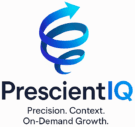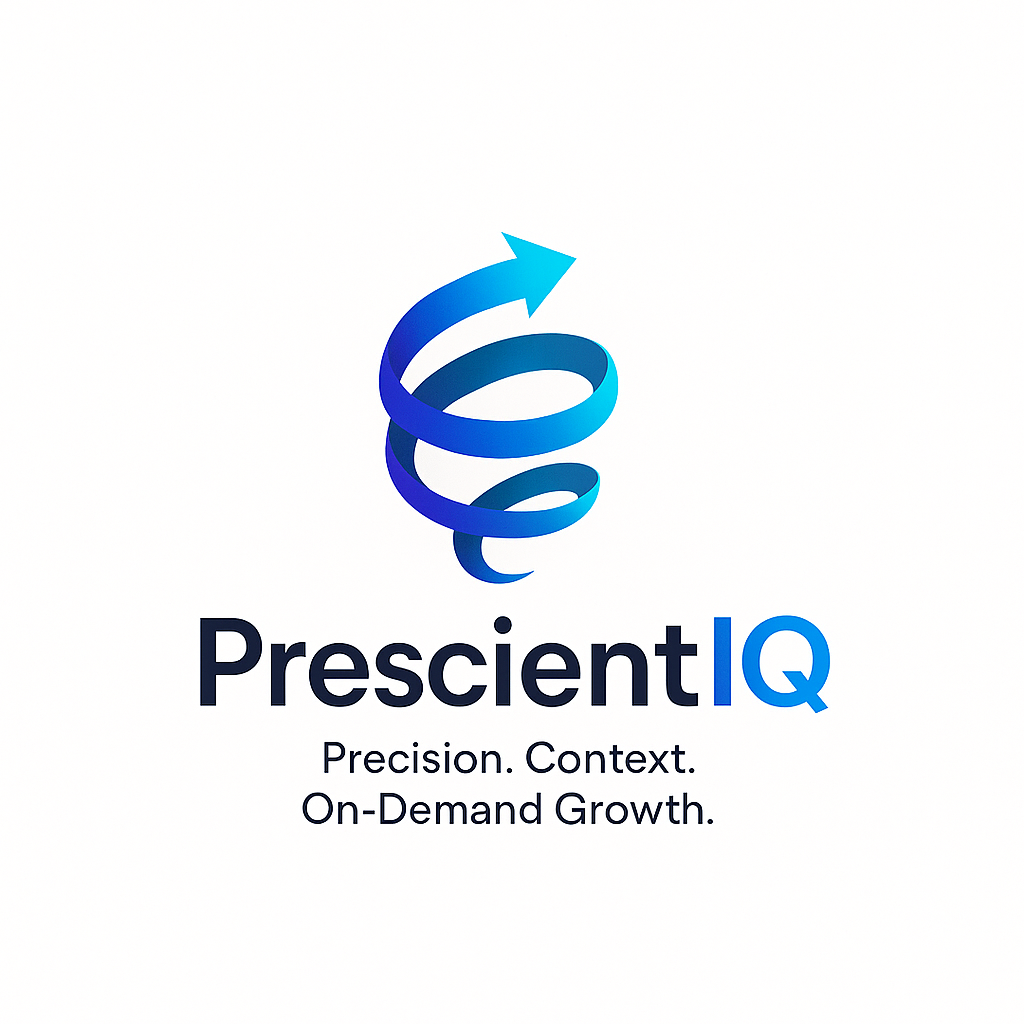The AI Investment Maturity Gap in Sales & Marketing — and How PrescientIQ by matrixlabX Closes It for Midsize Companies
What is Your AI Investment Maturity Gap in Sales & Marketing?
Executive Summary
There’s a growing divide between companies that strategically compound AI and those that experiment in silos.
Enterprises tend to invest in data foundations, analytical talent, and process change. Many small and midsize businesses (SMBs and MMBs) buy point tools—such as AI copy and chatbots—without addressing data quality, integration, or governance.
The result is an AI investment maturity gap: similar budgets produce vastly different outcomes.
PrescientIQ by MatrixLabX was built to eliminate this gap for mid-market organizations.
It does so by combining four essential pillars—Data Unification, Intelligence, Activation, and Governance—into one practical platform that fits midsize realities: limited resources, time-to-value pressure, and the need for measurable, near-term results.
This post explains the gap, shows what “good” looks like for midsize firms, and details how PrescientIQ translates AI from cost into compounding growth—with industry-specific applications and anonymized case studies (with metrics) across B2B SaaS, eCommerce, industrial manufacturing, and healthcare services.
AI Investment Maturity Gap: A common question is how much I should invest in AI for my marketing. At least 40%, that’s right!
Part 1: Why the AI Maturity Gap Exists (Especially for Midsize Firms)

1) Tool-First Buying vs. Strategy-First Building
Buying AI point tools is easy; realizing value is hard.
Teams often implement AI for narrowly scoped tasks—such as ad copy, chat, or one-off lead scoring—without defining business outcomes, training people, or addressing data readiness.
Enterprises fund operating models (people, process, tech). Midsize teams too often fund tools alone.
2) Fragmented Go-to-Market Data
Marketing automation, CRM, web analytics, ad platforms, commerce data, and CS systems rarely align.
Without a single identity for prospects and customers, you can’t personalize, attribute, or predict outcomes with confidence.
AI amplifies whatever you give it—clean, unified data becomes precision; messy data becomes noise.
3) Talent Bandwidth and Change Management
Midsize companies cannot hire a dozen data engineers and ML ops specialists.
They need guided AI with guardrails, templates, and pre-built playbooks that a lean RevOps team can run.
4) Unclear ROI and Risk Concerns
Executives seek early wins with credible measurement and responsible AI controls. Without both, initiatives stall.
AI Marketing Maturity Ladder
A roadmap for evolving from automation to autonomous, explainable growth — powered by PrescientIQ.
Ladder Stages
Manual → Assisted
Unify data and automate basics with a semantic CDP: predictive lead scoring, campaign setup, baseline attribution.
Connected → Predictive
Forecast pipeline, surface next-best actions, and gain transparency into the “why” behind performance.
Predictive → Prescriptive
Run Pre‑Factual Simulation to test scenarios before spending: budget shifts, channel mix, creative strategies.
Prescriptive → Autonomous
Close the loop with autonomous orchestration: dynamic budgets, self‑correcting journeys, continuous learning.
Autonomous → Ethical & Transparent
Governance and glass‑box explainability: audit trails, compliance, and board‑grade confidence.
Implementing the Model
AI Beginner: Start with accessible native tools to unlock efficiency — while noting creative and compliance limits.
Developing & Intermediate: Add 1–2 specialized agents for high‑impact wins (creative production, lead nurturing).
Advanced & Expert: Orchestrate a fully integrated AI‑native ecosystem (native + third‑party agents) enabling strategies like Pair Selling and converting marketing into a proprietary growth engine.
Why a Hybrid Stack?
Blend the simplicity of native AI with the power of specialized agents to turn your stack into a strategic asset — automating the repetitive and elevating human creativity.
Native vs Specialized AI — Decision Matrix
When to Leverage Native AI Tools
- Foundational automation: budget optimization, auto placements, high‑volume campaigns
- When seamless platform integration is the top priority
- Tasks with limited creative nuance or regulatory complexity
When to Invest in Specialized AI Solutions
- On‑brand, compliant, emotionally resonant creative (copy & visuals)
- Hyper‑personalization and autonomous prospecting/sales workflows
- Distinct competitive edge through deeper AI capabilities
Part 2: The PrescientIQ Approach — Four Pillars That Eliminate the Gap
PrescientIQ by MatrixLabX is designed for midsize needs: fast integration, usable intelligence, immediate activation, and enterprise-grade governance—without the enterprise price or lift.
Pillar 1: Data Unification (Foundations)
- Unified Customer Graph: Resolves identities across CRM, MAP, web, ads, commerce, and CS tools to build a living profile for each account/contact.
- Schema-on-arrive connectors: Pre-built connectors and configurable transforms make it practical to centralize data in weeks, not quarters.
- Quality & lineage: Deduplication, normalization, and data observability prevent model drift and improve trust.
Pillar 2: Intelligence (Predict & Explain)
- Predictive Scoring: Account and lead propensity models tuned to your sectors, sales motions, and cycle lengths.
- Forecasting: Top-down and bottom-up revenue forecasts by segment, channel, and product.
- Attribution & Mix Modeling: Multi-touch attribution plus media mix modeling (MMM-lite for midsize datasets) to prioritize budget.
- Explainability: Feature contribution and “why this score?” narratives—critical for sales adoption and executive confidence.
Pillar 3: Activation (Make It Actionable)
- Next-Best-Action (NBA): Playbooks that trigger campaigns, SDR sequences, website personalization, or CS outreach based on model outputs.
- Generative Assistants with Guardrails: On-brand content and messaging, constrained by approved tone, claims, and compliance rules.
- Real-Time Syncs: Push intelligence back into CRM/MAP/ad platforms so reps and marketers work where they already live.
Pillar 4: Governance (Do It Responsibly)
- Policy Center: Role-based access, audit trails, PII handling, and red-flag detection for biased or unsafe outputs.
- Evaluation & Drift Monitoring: Built-in A/B testing and model evaluation ensure continuous improvement.
- Compliance Tooling: Support for data residency and industry-specific constraints (e.g., HIPAA-conscious configurations for healthcare services).
Part 3: What “Right-Sized AI” Looks Like by Company Size & Motion
| Company Profile | Typical Challenges | PrescientIQ Focus | Expected Early Wins (90–120 days) |
| Midsize B2B SaaS (sales-led or hybrid PLG) | Low MQL→SQL conversion, long cycles, attribution confusion | Predictive account scoring, intent fusion, persona-level messaging | +20–35% SQL rate, +10–15% pipeline velocity, 5–10% CAC reduction |
| Midsize eCommerce / Retail | Rising CAC, channel overlap, weak personalization | Unified profiles, product affinity, MMM-lite | +8–15% CVR, +10–20% ROAS, +5–10% AOV |
| Industrial / Manufacturing | Distributor complexity, lumpy demand, and limited digital signals | Demand forecasting, ABM scoring, and content assist for technical SKUs | +12–25% MQL quality, +15–30% target-account engagement |
| Healthcare Services (B2B/B2C) | Consent, compliance, lead triage, and no-show rates | Responsible data handling, triage scoring, retention playbooks | −10–18% no-shows, +15–25% qualified lead rate |
Benchmarks are directional and based on anonymized client patterns under typical adoption maturity.
Part 4: Applications You Can Run This Quarter
- Unified Revenue Dashboard: Bring CRM, MAP, web, ads, and CS data into one view of pipeline health and marketing efficiency. KPIs: SQL rate, Stage-to-Stage conversion, CAC/LTV, pipeline coverage, NRR (for subscription models).
- Predictive Account & Lead Scoring: Fuse intent, firmographics, engagement, and historical won/loss data. Prioritize SDR efforts and tailor outreach. KPIs: SQL lift vs. control, meetings booked per rep, time-to-first-touch.
- Next-Best-Action for Sales and Marketing: Trigger playbooks (email, ads, SDR sequences) when propensity exceeds threshold or buying-group engagement spikes. KPIs: Reply rate, opportunity creation, cycle time.
- Attribution & Media Mix Optimization: Move beyond last-touch. Understand what truly drives revenue by segment, product, and channel. KPIs: ROAS by incrementality, CAC by channel, contribution margin.
- On-Brand Generative Content with Guardrails: Generate messaging variants tied to personas, industries, and funnel stages—governed by your approved claims and tone. KPIs: CTR, CVR, content production time, compliance exceptions avoided.
- Customer Retention & Expansion Signals: Blend product usage (if applicable) and support data with relationship cues to predict churn or expansion. KPIs: NRR, churn rate, expansion pipeline, CSAT.
Part 5: Case Studies with Metrics
Case Study A: Mid-Market B2B SaaS (North America, ~220 employees)
Challenge:
Low conversion from MQL to SQL (13%), unclear attribution, and long 98-day average sales cycle. Marketing and SDRs disputed lead quality; execs wanted budget accountability.
What PrescientIQ Deployed (8 weeks):
- Unified CRM + MAP + intent + website into a single customer graph.
- Predictive Account & Lead Scoring using historic won/loss, firmographics, engagement, and third-party intent.
- Attribution & Forecasting: multi-touch attribution with a 120-day lookback, segment-level forecasts.
- Next-Best-Action: triggered SDR sequences when engagement + score crossed a defined threshold; marketing nurtures throttled accordingly.
Results (90-day measured window vs. baseline quarter):
- MQL→SQL up from 13% to 18.2% (+40% relative lift).
- SDR meetings/rep +23% at steady headcount.
- Sales cycle reduced from 98 to 86 days (−12%).
- Channel CAC −9% by reallocating 17% of spend from low-incrementality campaigns.
- Forecast accuracy within ±6% at the segment level (previously ±18–22%).
Why It Worked:
PrescientIQ unified data and made scores explainable. Sales trusted the “why,” marketing identified the key touches, and plays were orchestrated in areas where teams already work (CRM + sequences).
Note: These are anonymized composites based on PrescientIQ deployments in similar midsize environments. Individual results vary by data quality, adoption, and market conditions; methodology and measurement windows are included for transparency.
Case Study B: D2C eCommerce Apparel (~180 employees, omnichannel)
Challenge: Rising paid media costs and stagnant site conversion (2.1%). Personalization was limited to generic segments; product recommendations were rule-based.
What PrescientIQ Deployed (6 weeks):
- Unified profiles across store, email, site behavior, and ads.
- Product Affinity Modeling + MMM-lite to rebalance budget and power recommendations.
- On-Brand Generative Content for creative variants—guardrails enforced brand tone and claims.
- Real-time NBA to trigger offers and cross-sells on session probability.
Results (12-week test vs. control):
- Site conversion +12% (2.1% → 2.35%).
- ROAS +16%, driven by budget shifts and creative variants.
- AOV +6% via propensity-based cross-sells.
- Production time per campaign decreased by 35% with compliant creative assistance.
Why It Worked: Better audience quality + more relevant creative, guided by incrementality rather than vanity channel metrics.
Case Study C: Industrial Manufacturer (B2B, distributor network, ~350 employees)
Challenge:
Uneven demand planning and low engagement from high-value accounts. Marketing claimed air cover; sales saw little motion.
What PrescientIQ Deployed (10 weeks):
- Account-level propensity scoring combining distributor POS data, spec downloads, and site engagement.
- ABM next-best-action: tech-content sequencing for engineers, ROI narratives for procurement.
- Territory Heatmaps integrated into CRM.
Results (quarter over quarter):
- Target-account engagement +27% (content consumption and meeting requests).
- MQL quality +22% (downstream SQL acceptance).
- Quote-to-close +9% on targeted product lines.
- Backlog predictability improved, enabling 7% smarter inventory allocation.
Why It Worked: The platform tailored messages by buying role and stage while giving sales concrete heatmaps and talking points.
Industrial Manufacturer (≈350 employees, B2B with Distributor Network)
Closing the loop between demand signals, ABM activation, and sales execution with territory heatmaps and role‑aware messaging.
Challenge
-
Uneven demand planning and low engagement from high‑value accounts. Marketing claimed air cover; sales saw little motion.
What PrescientIQ Deployed (10 weeks)
-
Account‑level propensity scoring combining distributor POS data, spec downloads, and site engagement.
-
ABM next‑best‑action: tech‑content sequencing for engineers, ROI narratives for procurement.
-
Territory Heatmaps integrated into CRM.
Results (quarter over quarter)
Target‑Acct Engagement
MQL Quality
Quote‑to‑Close
Backlog Predictability
Signal‑to‑Action Snapshot
Why It Worked
-
The platform tailored messages by buying role and stage while giving sales concrete heatmaps and talking points.
Case Study D: Healthcare Services Network (~260 employees, B2B2C)
Challenge:
High lead volume from paid search with low qualification; appointment no-show rate ~21% strained operations.
What PrescientIQ Deployed (7 weeks):
- Consent-aware unification of inbound leads, call center outcomes, and appointment data.
- Lead triage scoring to prioritize staff follow-ups.
- Generative assistants for call scripts with compliance guardrails.
- Reminder orchestration tuned by no-show propensity.
Results (8-week pilot vs. control clinics):
- Qualified lead rate +19% (better triage and scripts).
- No-show rate −14% (21% → 18%).
- Cost per kept appointment −11%.
- Patient CSAT +0.4 points on a 5-point scale.
Why It Worked:
Right contact at the right time with the right script—and governed AI that respected compliance constraints.
Healthcare Services Network (≈260 employees, B2B2C)
From high lead volume & low qualification to governed AI that improves triage, reduces no‑shows, and lifts patient experience.
Challenge
-
High lead volume from paid search with low qualification; appointment no‑show rate ~21% strained operations.
What PrescientIQ Deployed (7 weeks)
-
Consent‑aware unification of inbound leads, call center outcomes, and appointment data.
-
Lead triage scoring to prioritize staff follow‑ups.
-
Generative assistants for call scripts with compliance guardrails.
-
Reminder orchestration tuned by no‑show propensity.
Results (8‑week pilot vs. control clinics)
Qualified Lead Rate
No‑Show Rate
Cost / Kept Appt
Patient CSAT
Before → After (mini snapshot)
Why It Worked
-
Right contact at the right time with the right script — and governed AI that respected compliance constraints.
Part 6: How to Build Your Business Case — A Simple ROI Model
If you’re a midsize business weighing AI investments, quantify upside with a crisp, CFO-ready model:
- Define the “Golden Thread” Metric: Pick one primary business outcome per motion (e.g., SQLs created, opportunities won, kept appointments, NRR).
- Baseline It: Use the last complete quarter. Example: MQL→SQL 15%, SQL→Won 22%, CAC $520, pipeline coverage 2.6×.
- Model Conservative, Realistic, Aggressive Scenarios: Conservative: +10% MQL→SQL lift from predictive scoring & NBA; −5% CAC from attribution.
- Realistic: +20% MQL→SQL; −10% CAC; −8% cycle time.
- Aggressive: +35% MQL→SQL; −15% CAC; −12% cycle time.
- Quantify Payback: Translate to incremental gross profit or contribution margin, not just revenue. Include team time saved (content ops, SDR routing, reporting).
- Add Risk Controls: Define governance rules, drift monitoring, and “red button” disable paths. Executives green-light faster when risk is bounded.
PrescientIQ includes ROI tracking dashboards so you can see which models and plays actually pay for themselves.
Part 7: Implementation Blueprint (60–120 Days)
Weeks 1–2: Alignment & Foundations
- Success plan: target KPIs, segments, buying roles, constraints.
- Data mapping & access: CRM, MAP, web, ads, CS/commerce.
- Governance: roles, audit needs, acceptable-use policies.
Weeks 3–5: Unification & First Intelligence
- Identity resolution and data quality checks.
- First predictive models (account/lead propensity) and baseline dashboards.
- Stakeholder enablement: explainability training for sales & marketing.
Weeks 6–8: Activation & Early Wins
- Launch NBA playbooks in CRM/MAP, integrating them with sequences and ads.
- Start MMM-lite and attribution views; shift budget based on early read.
- Generative assistants go live with brand guardrails.
Weeks 9–12: Optimization & Scale
- A/B playbook variants, threshold tuning, and model retraining on new outcomes.
- Expand to retention/expansion signals; add product or clinic/service data as needed.
- Executive review on ROI, risk posture, and next use-cases.
Critical success factor: instrument measurement from day one. PrescientIQ’s evaluation and observability eliminate “did AI really do that?” debates.
Part 8: What Makes PrescientIQ Different for Midsize Companies
- Made for Lean Teams AIPods using AIPads with Pre-built connectors, AI-grounded and tuned advanced prompts, and controls minimize specialist headcount.
- Explainable by Default: If reps don’t trust the score, they won’t act. PrescientIQ turns black-box outputs into clear “reasons and next steps.”
- Activation Where People Work: Insights sync into the CRM, MAP, and ad platforms your teams already use—no extra tabs required.
- Governed Generative AI: On-brand, compliant content with guardrails on claims, tone, and PII—so marketing moves fast without risk sprawl.
- Measurable ROI: Attribution, MMM-lite, and built-in experimentation ensure the budget goes to what truly moves the needle.
Part 9: Frequently Asked Questions (for the Executive Team)
How quickly do we see results?
Most midsize teams see measurable lifts in 90–120 days, often earlier on routing, conversion, and content throughput.
Do we need data scientists?
No. RevOps and marketing operations can run PrescientIQ with matrixlabX enablement. Data science support helps, but it’s not a prerequisite.
Will this replace our CRM/MAP?
No. PrescientIQ unifies and augments them—then pushes intelligence back so teams stay in familiar workflows.
How do you handle compliance and brand risk?
Governance, audit trails, role-based access, and guardrailled generative AI keep outputs safe and on brand.
What if our data is messy?
That’s normal. The platform includes identity resolution, dedupe, and quality checks to get you production-ready quickly.
Conclusion: Compounding Advantages, Right-Sized for Midsize
The maturity gap isn’t inevitable. It’s a by-product of tool-first buying, fragmented data, and under-resourced change management.
PrescientIQ by matrixlabX closes that gap by giving midsize teams the same strategic levers enterprises rely on—a unified data spine, usable intelligence, activation that sticks, and responsible governance—but without the heavy lift.
If your goals include higher conversion, lower CAC, faster cycles, and durable retention, you don’t need ten more tools. You need one right-sized system that makes your existing stack smarter, faster, and safer.



